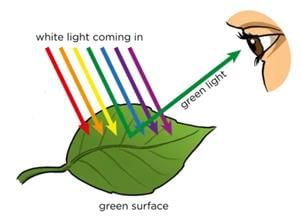Class 3 Exam > Class 3 Questions > The leaves of plants are green. The reason is...
Start Learning for Free
The leaves of plants are green. The reason is:
- a)they are born from green-coloured seeds
- b)photosynthesis occurs in the leaves
- c)the presence of a green pigment called chlorophyll
- d)due to the presence of network of veins
Correct answer is option 'C'. Can you explain this answer?
Verified Answer
The leaves of plants are green. The reason is:a)they are born from gre...
Leaves of plants are green because they contain the green pigment, chlorophyll. However, plants contain chromoplasts but they are not green pigments.


Most Upvoted Answer
The leaves of plants are green. The reason is:a)they are born from gre...
Explanation:
Chlorophyll:
- Chlorophyll is a green pigment present in the chloroplasts of plant cells.
- It plays a crucial role in the process of photosynthesis.
- Chlorophyll absorbs light energy from the sun and converts it into chemical energy, which is used by the plant to produce glucose.
Photosynthesis:
- Photosynthesis is the process by which plants, algae, and some bacteria convert light energy, carbon dioxide, and water into glucose and oxygen.
- This process takes place in the chloroplasts of plant cells, specifically in the chlorophyll-containing organelles called thylakoids.
Green Color:
- The green color of leaves is due to the presence of chlorophyll.
- Chlorophyll absorbs most wavelengths of visible light except for green light, which it reflects, giving the leaves their green color.
- This is why leaves appear green to our eyes.
Importance of Chlorophyll:
- Chlorophyll is essential for photosynthesis, as it captures light energy needed for the process.
- Without chlorophyll, plants would not be able to produce glucose, which serves as their food source.
In conclusion, the green color of leaves is primarily due to the presence of the green pigment chlorophyll, which plays a vital role in the process of photosynthesis.
Chlorophyll:
- Chlorophyll is a green pigment present in the chloroplasts of plant cells.
- It plays a crucial role in the process of photosynthesis.
- Chlorophyll absorbs light energy from the sun and converts it into chemical energy, which is used by the plant to produce glucose.
Photosynthesis:
- Photosynthesis is the process by which plants, algae, and some bacteria convert light energy, carbon dioxide, and water into glucose and oxygen.
- This process takes place in the chloroplasts of plant cells, specifically in the chlorophyll-containing organelles called thylakoids.
Green Color:
- The green color of leaves is due to the presence of chlorophyll.
- Chlorophyll absorbs most wavelengths of visible light except for green light, which it reflects, giving the leaves their green color.
- This is why leaves appear green to our eyes.
Importance of Chlorophyll:
- Chlorophyll is essential for photosynthesis, as it captures light energy needed for the process.
- Without chlorophyll, plants would not be able to produce glucose, which serves as their food source.
In conclusion, the green color of leaves is primarily due to the presence of the green pigment chlorophyll, which plays a vital role in the process of photosynthesis.

|
Explore Courses for Class 3 exam
|

|
Question Description
The leaves of plants are green. The reason is:a)they are born from green-coloured seedsb)photosynthesis occurs in the leavesc)the presence of a green pigment called chlorophylld)due to the presence of network of veinsCorrect answer is option 'C'. Can you explain this answer? for Class 3 2025 is part of Class 3 preparation. The Question and answers have been prepared according to the Class 3 exam syllabus. Information about The leaves of plants are green. The reason is:a)they are born from green-coloured seedsb)photosynthesis occurs in the leavesc)the presence of a green pigment called chlorophylld)due to the presence of network of veinsCorrect answer is option 'C'. Can you explain this answer? covers all topics & solutions for Class 3 2025 Exam. Find important definitions, questions, meanings, examples, exercises and tests below for The leaves of plants are green. The reason is:a)they are born from green-coloured seedsb)photosynthesis occurs in the leavesc)the presence of a green pigment called chlorophylld)due to the presence of network of veinsCorrect answer is option 'C'. Can you explain this answer?.
The leaves of plants are green. The reason is:a)they are born from green-coloured seedsb)photosynthesis occurs in the leavesc)the presence of a green pigment called chlorophylld)due to the presence of network of veinsCorrect answer is option 'C'. Can you explain this answer? for Class 3 2025 is part of Class 3 preparation. The Question and answers have been prepared according to the Class 3 exam syllabus. Information about The leaves of plants are green. The reason is:a)they are born from green-coloured seedsb)photosynthesis occurs in the leavesc)the presence of a green pigment called chlorophylld)due to the presence of network of veinsCorrect answer is option 'C'. Can you explain this answer? covers all topics & solutions for Class 3 2025 Exam. Find important definitions, questions, meanings, examples, exercises and tests below for The leaves of plants are green. The reason is:a)they are born from green-coloured seedsb)photosynthesis occurs in the leavesc)the presence of a green pigment called chlorophylld)due to the presence of network of veinsCorrect answer is option 'C'. Can you explain this answer?.
Solutions for The leaves of plants are green. The reason is:a)they are born from green-coloured seedsb)photosynthesis occurs in the leavesc)the presence of a green pigment called chlorophylld)due to the presence of network of veinsCorrect answer is option 'C'. Can you explain this answer? in English & in Hindi are available as part of our courses for Class 3.
Download more important topics, notes, lectures and mock test series for Class 3 Exam by signing up for free.
Here you can find the meaning of The leaves of plants are green. The reason is:a)they are born from green-coloured seedsb)photosynthesis occurs in the leavesc)the presence of a green pigment called chlorophylld)due to the presence of network of veinsCorrect answer is option 'C'. Can you explain this answer? defined & explained in the simplest way possible. Besides giving the explanation of
The leaves of plants are green. The reason is:a)they are born from green-coloured seedsb)photosynthesis occurs in the leavesc)the presence of a green pigment called chlorophylld)due to the presence of network of veinsCorrect answer is option 'C'. Can you explain this answer?, a detailed solution for The leaves of plants are green. The reason is:a)they are born from green-coloured seedsb)photosynthesis occurs in the leavesc)the presence of a green pigment called chlorophylld)due to the presence of network of veinsCorrect answer is option 'C'. Can you explain this answer? has been provided alongside types of The leaves of plants are green. The reason is:a)they are born from green-coloured seedsb)photosynthesis occurs in the leavesc)the presence of a green pigment called chlorophylld)due to the presence of network of veinsCorrect answer is option 'C'. Can you explain this answer? theory, EduRev gives you an
ample number of questions to practice The leaves of plants are green. The reason is:a)they are born from green-coloured seedsb)photosynthesis occurs in the leavesc)the presence of a green pigment called chlorophylld)due to the presence of network of veinsCorrect answer is option 'C'. Can you explain this answer? tests, examples and also practice Class 3 tests.

|
Explore Courses for Class 3 exam
|

|
Signup for Free!
Signup to see your scores go up within 7 days! Learn & Practice with 1000+ FREE Notes, Videos & Tests.























